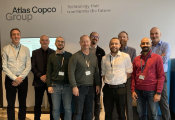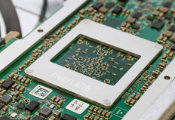Exploring Long-Range Coupling in Superconducting Spin Qubits: A Breakthrough powered by OPX
July 24, 2024 -- Researchers at Delft University of Technology have achieved a significant milestone in the field of quantum computing, as documented in a recent publication in Nature Physics. Their work demonstrates the strong, tunable coupling between two distant superconducting spin qubits, marking an important step towards scalable quantum information processing. This breakthrough leverages the unique properties of Andreev spin qubits (ASQs), showcasing their potential to integrate semiconductor and superconducting technologies for advanced quantum applications.
Superconducting spin qubits, specifically ASQs, represent a hybrid approach that combines the long coherence times of semiconductor spin qubits with the robust control offered by superconducting circuits. These qubits exploit the spin degree of freedom of electrons or localized holes, which is coupled to the supercurrent across a Josephson junction via spin-orbit interaction. This coupling enables fast and high-fidelity spin readout, a crucial feature for practical quantum computing applications.
In the context of quantum information processing, superconducting spin qubits offer several advantages. They have long coherence times due to the spin degree of freedom, which is less susceptible to environmental noise compared to charge degrees of freedom. This makes them suitable for quantum computing, where maintaining quantum coherence is critical. Additionally, their small size is beneficial for scaling up to large numbers of qubits.
The Delft team successfully demonstrated a strong, supercurrent-mediated coupling between two distant (approx. 25 μm) ASQs. This qubit-qubit interaction is of the longitudinal type and is both gate- and flux-tunable, achieving a coupling strength of up to 178 MHz. The coupling can be switched off in situ using a magnetic flux, highlighting the versatility and control of this system. Such characteristics are essential for implementing fast, two-qubit gates between remote spins, a significant challenge in current quantum computing architectures.
The research leverages the intrinsic spin-supercurrent coupling in ASQs, facilitating inductive multi-qubit coupling. The ASQs are embedded in quantum dot Josephson junctions, implemented in Al/InAs nanowires. The spin states in these qubits are intrinsically linked to the supercurrent via spin-orbit interaction, which allows for rapid and accurate readout using circuit quantum electrodynamics (cQED) techniques.
The experimental setup involved a device formed by two ASQs connected in parallel to a third Josephson junction with a gate-tunable Josephson inductance. This configuration defined two superconducting loops. The qubits, embedded in Al/InAs nanowires, were controlled by electrostatic gates and a magnetic field. The team utilized cQED techniques for readout, ensuring precise measurement and control of the qubit states.
The ability to tune the qubit-qubit coupling strength by varying the magnetic flux through the superconducting loops and the gate voltage controlling the Josephson inductance allows for dynamic coupling adjustments. This feature is essential for scalable and adaptable quantum circuits. This is where the OPX, QM’s processor-based state-of-the-art quantum control system, plays a key role.
The processor-based OPX controller provides a comprehensive control solution tailored for quantum technologies, offering real-time control and feedback capabilities essential for manipulating semiconducting-superconducting qubits. In this specific case, the OPX system helped the researchers perform Real-Time Flux Control. OPX dynamically adjusts the magnetic flux through the superconducting loops on-the-fly, ensuring optimal coupling strength between the qubits. This real-time control is crucial for implementing fast, high-fidelity two-qubit gates and for switching the coupling on and off as needed. Moreover, it provides precise control over the pulse sequences applied to the electrostatic gates and magnetic flux lines, essential for accurate qubit manipulation. OPX allows for fine-tuned pulse shaping and timing, minimizing errors and enhancing gate fidelities.
Quantum Machines’ processor-based OPX is designed to handle the complexities of quantum experiments, providing the necessary infrastructure to implement dynamic and adaptive control protocols. This integration ensures that experimental setups, like the one demonstrated by the Delft team, can be scaled and adapted for more complex quantum computing tasks. The OPX system’s ultra-fast feedback and control capabilities are particularly valuable in tuning the qubit-qubit interactions and optimizing the performance of quantum gates.
This research addresses one of the critical challenges in quantum computing: The implementation of fast, long-range two-qubit gates. Traditional photon-mediated spin-spin coupling methods offer limited interaction strengths, typically around 10 MHz. The demonstrated coupling strength of 178 MHz in the Delft experiment significantly surpasses this, enabling faster and more efficient quantum gate operations.
The longitudinal nature of the coupling in this setup offers advantages over transverse coupling, which imposes constraints on qubit frequencies. The strong and tunable coupling achieved in this study can facilitate the implementation of fast, high-fidelity two-qubit gates, essential for quantum error correction and complex quantum algorithms.
The tunable nature of the coupling also opens up possibilities for more complex quantum algorithms and error correction methods, essential for the development of robust quantum computers. Integrating ASQs into existing quantum architectures could enhance their performance, providing a pathway to high-fidelity, scalable quantum systems.
The research conducted by Delft University of Technology represents a significant advancement in the quest for scalable quantum computing. By demonstrating strong, tunable coupling between distant superconducting spin qubits, the team has paved the way for more efficient and adaptable quantum circuits. The integration of advanced control systems, such as Quantum Machines’ processor-based OPX, further enhances these capabilities, bringing us closer to the realization of practical quantum computers.




































